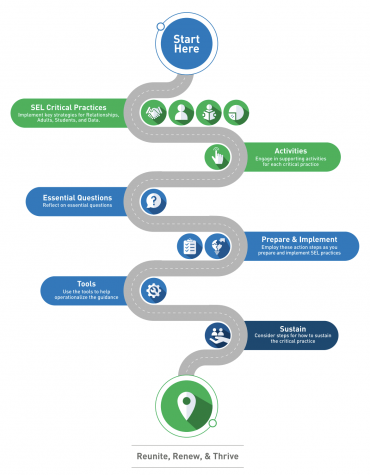‘You have to name it to tame it”: DGN to become more ‘trauma-sensitive’ amid unprecedented year
TRAUMA-SENSITIVE APPROACH: All DGN staff members have been trained in responding to situations with a “trauma-sensitive” approach.
December 16, 2020
In combats against mental health stigma and to create a more welcoming environment for students, a trauma-sensitive approach and related strategies are now implemented into the DGN community.
A trauma-sensitive approach refers to a school becoming more welcoming and supporting and while addressing trauma’s impact on learning at the center of their educational mission.
“[Trauma Sensitive Approach] is looking at the situation and finding out the why, and you’re doing it through an empathetic lens knowing that all the pieces are not by themselves,” Associate Principal for Staff & Students Kelly Zuerner said, “[CSSS department and DGN staff members] are trying to understand the student as a person, as an individual. Not as an attendance concern or a failing grade. You’re looking at more of a human aspect of that.”
Associative Principal for Student Services Erin Ludwick speaks on the importance of trauma-sensitive approaches within the school community.
“The stigma of mental health being talked about a lot more now, and the fact we can already admit that we’re anxious or nervous or scared, I think it’s a good thing and something good for the school. We have to ensure that the conversation continues,” Ludwick said, “that’s on me, that’s on administration, and that’s also on students and staff making sure that they are always articulating what needs are in front of them.”
DGN staff members, including administrators and teachers, are trained in a trauma-sensitive way in how to react to certain situations and take the proper actions in a mental health situation.
“The whole staff has had a fundamental introduction in trauma-sensitive approaches,” Ludwick said, “people know the words, people know the expectation. We’ve given examples on how to respond in a trauma-sensitive way.”
Trauma-Sensitive vs. Trauma-Informed
School psychologist Angela McAndrews believes that for DGN to become a more welcoming environment, the difference between trauma-sensitive and trauma-informed must be drawn.
“[Trauma-informed] came out of the behavioral health field. The Substance Abuse and Mental Health Services Association describes this as therapists utilizing a behavioral health services approach in which they have an understanding of trauma and an awareness of the impact it can have across settings, services, and populations,” McAndrews said, “[trauma-sensitive] is in reference to a school taking a look at how current situations in their buildings are impacting the school community and its students. With that, respond in a way that the students feel welcomed, safe, and supported in the building.”
The term trauma-sensitive encompasses the entire school community, with each person having a role in creating a safe mental health environment.
According to The Trauma and Learning Policy Initiative (TLPI), “[the term trauma-sensitive] also helps emphasize that, while behavioral health services will be an important part of the effort, helping traumatized children learn at school requires more—it also requires a school-wide culture that helps children feel safe and supported in all parts of the school.”
Reunite, Renew and Thrive: SEL Roadmap for Reopening School

Downers Grove North and the CSSS department will be following the CASEL SEL roadmap to be a more trauma-sensitive school.
“Schools at any stage of SEL implementation can use this roadmap to build upon existing efforts around community-building, school climate improvement, student well-being and mental health, trauma-responsive learning environments, restorative practices, and social and emotional competency development,” according to CASEL’s SEL Roadmap, “[SEL Roadmap] is also intended to help you reflect and act upon what you can do that is different—to leverage the historical moment we are in.”
The SEL Roadmap outlines four SEL Critical Practices along with three to five supplemental activities. Users then work through the following categories: Essential Questions, Actions to Prepare & Implement, and Tools to Support the Actions.
“It is an approach that takes into account the impact that trauma, passed or continual, has on someone,” Ludwick said in regards to the decision to follow the roadmap, “there’s a big focus on relationships and making safe and comfortable relationships.”
COVID-19
Soon after the initial lockdown on Mar. 13, Ludwick and Dr. Vince Walsh-Rock introduced mental health resources for the community to address the tolls caused by the COVID-19 pandemic that were taken on students and teachers alike.
“Back in March, Dr. Vince Walsh-Rock, who is my counterpart at [DGS], he and I immediately started compiling resources that were coming out about dealing with the emotional aftermath of COVID,” Ludwick said, “we’ve introduced [mental health resources] on a much more broader level and it’s because of the trauma that COVID-19 and the social unrest that has impacted our community.”
According to National Child Traumatic Stress Network (NCTSN) in Trauma-Informed School Strategies during COVID-19, “Students who have trauma histories, as well as those who are experiencing high levels of stress caused by the COVID-19 crisis, might be less likely to engage in opportunities for remote learning . . . Educators can create a safe and welcoming experience for all students by providing consistency and structure, praising students for participation, and modeling a calm and non-judgmental approach.”
School counselor Katelyn Pantke explains the significance of trauma brought by the COVID-19 pandemic and the outlook mental health professionals must take from now on.
“It’s understanding that there are significant traumas that are different for each student. COVID-19 is a sensitive trauma, which is why we need to take a specific approach because everyone has trauma from this experience,” Pantke said, “we used to have this mindset that trauma was this severe catastrophe when it’s not. It can be something less visible.”
Future of Mental Health Awareness in DGN
Downers Grove North High School has made efforts in prioritizing the emotional and mental wellbeing of students within a remote learning setting. Pantke shares how DGN will continue to have the conversation.
“I think it’s being talked about so openly because it’s a collective trauma, this is something that we all share,” Pantke said, “By opening up that conversation and saying ‘we’re acknowledging this,’ we’re saying that we recognize this.”
Erika’s Lighthouse sponsor and special education teacher Karen Brown hopes that the introduction of a trauma-sensitive approach could lead to a safer mental health environment.
“Trauma has lots of different layers so it’s really important for students to realize that it affects a person in different ways and being able to talk about it is the most important thing,” Brown said, “I think a lot of students don’t reach out because they don’t know what’s available to them, or they are afraid. The more we can do to open that up and open more options for students, it’s going to be much more beneficial.”



























